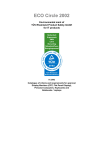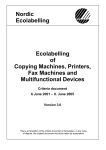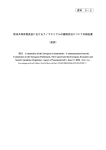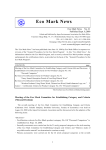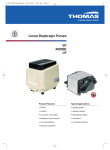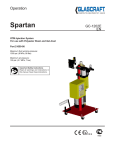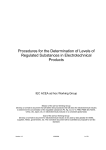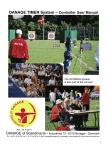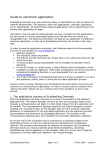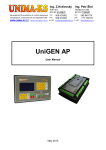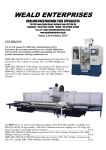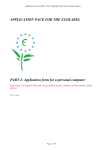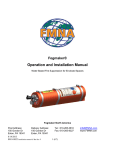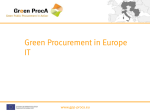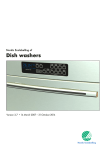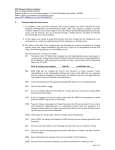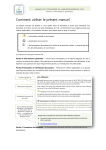Download Nordic Ecolabelling - Provincia di Torino
Transcript
Nordic Ecolabelling Ecolabelling of Printers and Fax Machines Criteria document 14 June 1999 – 13 June 2002 Version 2.2 This is a translation of the document in Swedish: “Miljömärkning av Skrivare och Faxar” . In any case of dispute, the original document should be taken as authoritative. Joint Nordic ecolabelling In November 1989, the Nordic Council of Ministers adopted a measure to implement a voluntary, positive ecolabelling scheme in the Nordic countries. The scheme is administered by national boards which cooperate through the Nordic Ecolabelling Board. The board among other things choose product groups and lay down the final criteria. Secretariates in the participating countries are responsible for implementing the scheme on national level. The objective of ecolabelling is to provide information to consumers to enable them to select products that are the least harmful to the environment. Ecolabelling is intended to stimulate environmental concern in product development. In its work on ecolabelling Nordic Ecolabelling follows the ISO 14024 standard: "Environmental labels and declarations - Guiding principles". The product groups and environmental and performance requirements selected by Nordic Ecolabelling reflect the objectives, principles, practices and requirements of the standard. ISO 14024 includes the requirements that criteria should be objective, reasonable and verifiable, that interested parties should be given the opportunity to participate and that account should be taken of their comments. The criteria are based on evaluation of the environmental impacts during the actual products’ life cycle. Based on a thorough examination the criteria set requirements towards a number of factors considered environmentally harmful. Upon application all products found to meet the requirements of the criteria are awarded the environmental label. Due to new knowledge and production methods the criteria must be updated regularly. The period of validity of each set of criteria is 2-3 years. New revised criteria are presented at least 6 months prior to the expiry date. A handling fee is paid upon submission of a complete application. The turnover value of the actual product determines the additional annual fee. Denmark: Ecolabelling Denmark 15 Gladsaxe Møllevej DK-2860 SØBORG ! +45 39 69 35 36 fax +45 39 69 21 22 Iceland: Umhverfishmerki, Environmental and Food Agency of Iceland Pb 8080 IS-128 REYKJAVIK ! +354 585 1000 fax +354 585 1010 Finland: SFS-Ecolabelling PB 116 FIN-00241 HELSINGFORS ! +358 9 1499 331 fax +358 9 1499 3320 Norway: Ecolabelling Norway Kristian Augusts gate 5 N-0164 OSLO ! +47 22 36 57 40 fax +47 22 36 07 29 Sweden: SIS Eco-labelling Box 6455 S- 113 82 STOCKHOLM ! +46 8 610 30 00 fax +46 8 34 20 10 Ecolabelling of Printers and Fax Machines 061/2.2 – 5 October 2000 Table of contents page 1. Summary 1 2. Definition of the product group 2 3. Nordic market survey 2 4. The environmental impact of printers and fax machines 2 4.1 The structure of the products 4.2 Environmental impact 4.3 Scope of the criteria 5. Ecolabelling criteria 5.1 5.2 5.3 and 5.4 5.5 6. Requirements for Requirements for Requirements for ink cartridges Requirements for Requirements for 2 3 4 4 products 4 production 12 packaging for machines, toner containers 12 recycling 13 consumer information 14 Other requirements 6.1 Requirements of the authorities 6.2 Quality assurance and environmental protection 6.3 Marketing 7. Testing, reporting and control 7.1 Selection of test laboratory 7.2 Test methods 7.3 Reporting and control 15 15 15 16 16 16 17 17 8. Application instructions 18 9. Design of the environmental label 19 10. Validity of the criteria document 19 11. Future criteria 19 APPENDIX 1 Certificate on the requirements for construction APPENDIX 2 Certificate on the requirements for materials APPENDIX 3 Certificate on the requirements for the use of chemicals in manufacture APPENDIX 4 Certificate on the requirements for packaging APPENDIX 5 Declaration of the content of the product APPENDIX 6 Test Conditions for Dust Concentration Measurements on Copiers, Annex 1 to the ”Basic requirements for the award of the environmental label”, according to RAL-UZ 62 APPENDIX 7 Test Conditions for Ozone Concentration Measurements on Copiers, Annex 2 to the ”Basic requirements for the award of the environmental label”, according to RAL-UZ 62 APPENDIX 8 APPENDIX 9 Testing methods for ozone and dust emissions Marketing of ecolabelled products Nordic Ecolabelling Printers and Fax Machines 061/2.2 5 October 2000 1. 1 (19) Summary Nordic environmental labelling criteria are imposed in order to promote a reduction in the number of material types in use, reduction of the use of environmentally hazardous substances and energy, as well as improvements in the durability and recyclability of products. It has also been considered important to define requirements for product performance, such as a low noise level and safety in use. Criteria are specified for the design of and materials used in the product. Printers, fax machines and printer/fax combos must be built and equipped on a modular basis and should be constructed to make dismantling easy, for example in connection with repair and recycling. Requirements are also laid down as regards the cadmium and lead content in plastic parts, chlorine-based plastics and brominated and chlorinated flame retardants in the housing and chassis. Requirements are also laid down for photosemiconductors in photosensitive layers, construction of toner cartridges, recycling and re-use of toner and ink jet cartridges, heavy metals in batteries, and the content of substances that are harmful to health and the environment in toners and inks. Printers, fax machines and printer/fax combos must have low air-borne emissions of ozone, dust and volatile organic compounds (VOCs). The machines must also incorporate an energy-saving function. The criteria include performance requirements, such as noise and safety in use. The machine must meet the requirements for maximum sound power levels during operation. Electromagnetic compatibility and electrical safety must meet the requirements in the specified EU directives. Substances with ozone-depleting properties declared pursuant to Montreal Protocol must not be used in the manufacture of electronic or other components or in the manufacture of packaging. The environmental labelling criteria also include requirements for recycling, packaging and instructions for use. Specified solvents may not be used in the manufacture of packaging materials. Packaging must not contain chlorine-based plastics or lead or cadmium stabilisers. Plastics in packaging must be identified. The recycling requirements mean that the manufacturer, dealer or importer must collect used equipment and toner and ink cartridges for re-use or recycling as materials. At least 90% of the plastics and metals in the housing and chassis must be technically suited to material recycling. This document may be copied only in its entirety and without any type of change. Quotations may be made provide that Nordic Ecolabelling is stated as the source. 2(19) 2. Nordic Ecolabelling Printers and Fax Machines 061/2.2 5 October 2000 Definition of the product group These Nordic ecolabelling criteria apply to printers, fax machines and combined printers and faxes (printer/fax combos) for use in offices and homes. The printers encompassed by the criteria may be based on various print technologies: laser, LED, ink-jet or matrix technology. The fax machines encompassed by the product group may be based on laser, LED, ink-jet or thermal technology. The criteria also encompass combined faxes/printers without copying boards. Copier-based combos with copying boards are encompassed by the criteria for photocopying machines. Specific environmental criteria have been drawn up for PCs and photocopiers and they are accordingly not encompassed by these criteria. 3. Nordic market survey Table 1: Sales of faxes and printers in the Nordic countries in 1997. Printers Faxes Denmark, DKK million 766 (approx. 536,000 115 (approx. 40,000 items) items) Finland, FIM million 600 (approx. 200,000 125 (approx. 36,000 items) items) Norway, ECU million 117 (approx. 288,000 65 1) items) Sweden, SEK million 1,267 (approx. 500,000 295 (approx. 137,000 items) items) 1) includes faxes, answering machines and equipment for video and tele-conferencing 4. The environmental impact of printers and fax machines 4.1 The structure of the products Printers use various printing technologies, for example, laser, LED (light emitting diode), ink-jet or matrix technology. Fax machines use laser, LED, ink-jet or thermal printing technologies. Laser printing is a xerographic process whereby a laser beam and a toner act on a photosensitive drum from which toner particles are transferred to paper. A fixing roller melts the toner powder and presses it onto the paper. The powder melts at about 200 degrees Celsius, making it necessary to cool the machine with fans. LED printers work on the same principles as laser printers, but use light emitting diodes instead of lasers. In ink-jet printers the ink-jet nozzle in the printing head sprays ink onto the paper. These machines may incorporate one or more ink cartridges. This type of machine requires no cooling and has a very low noise level when printing. In stand-by mode, the machine is very quiet. This document may be copied only in its entirety and without any type of change. Quotations may be made provide that Nordic Ecolabelling is stated as the source. Nordic Ecolabelling Printers and Fax Machines 061/2.2 5 October 2000 3 (19) In matrix printers, pins are pressed through the ink ribbon onto paper, thus producing dots which form a character. The printing head usually consists of 9 or 24 pins. Matrix printing is the only method encompassed by these criteria that allows carbon copies to be produced. However, the noise level is higher than in other printing methods. In stand-by mode the printers consume very little energy, they generally require no cooling fans and are considered to be very quiet. Thermal transfer fax machines print on heat-sensitive paper. Printer/fax combos use laser or ink-jet technology. Printers and faxes consist of housing and chassis and include the following components: fan and motor, transformer, printed board assemblies, capacitors, cords and cables, indicator lamps, switches, displays, batteries and toner cartridges. Toner cartridges may incorporate a toner container, drum and a developer either combined, usually in smaller machines, or as separate components, in larger machines. Toner cartridge components may be disposable or reusable. The machine may incorporate a toner container (containing powder or ink) as a separate unit. 4.2 Environmental impact The impact on the environment of products such as printers and fax machines comes about through the exploitation of natural resources such as ore and oil, the production of raw materials, the production of electronic and other components, and their assembly into a finished product. The products also have an environmental impact during operaton, transport and servicing, as well as at the waste disposal stage in recycling, destruction and disposal. Energy is consumed in manufacture, transport and use. Recycling The manufacture of the electronic components requires large amounts of chemicals and generates large quantities of waste products. Natural resources are saved and the amount of waste deposited is reduced through the re-use and recycling of components. Production Many substances are used in the manufacture of printers and fax machines. Some of these have properties which make them hazardous to health or to the environment, for example: chlorinated solvents used as cleaning substances in manufacture mercury in batteries, circuit cards and displays cadmium, for example, in batteries and as colouring agents and stabilisers in plastics lead, for example, in soldering tin, batteries, circuit cards, connecting devices and in colouring agents and stabilisers in plastics copper, for example, in cables and circuit cards arsenic, zinc, chrome and many other metals in various components brominated flame retardants, such as PBB and PBDE in plastics in the housing, chassis and cable insulation and TBBPA in circuit cards chloroparaffins in cable insulation This document may be copied only in its entirety and without any type of change. Quotations may be made provide that Nordic Ecolabelling is stated as the source. 4(19) Nordic Ecolabelling Printers and Fax Machines 061/2.2 5 October 2000 Use During use, the energy consumption of the machine is an important environmental factor. Other such factors include emissions of ozone, noise and volatile organic compounds. The printer's capacity to produce double-sided prints brings substantial savings in the quantity of paper used. The consumption of toner/ink is another factor with a significant environmental impact. Packaging The environmental impact of packaging depends on the size of packaging, proportion of recycled fibres, proportion of plastics, choice of ink, etc. 4.3 Scope of the criteria The criteria impose requirements on production and composition of the product, structure, materials, chemicals, labelling of components, packaging, waste disposal, recycling, energy consumption, emissions to air, noise level and safety in use. Environmental labelling requirements are set for printers and fax machines in order to promote, for example: reduction in the number of material types and amounts minimisation of the use of environmentally hazardous substances reduction of energy consumption during use longer service life, improved durability and greater safety in use recyclability of products a good work environment. The criteria have been fixed on the basis of the environmental impact of the whole lifecycle of the products and the principles of increased recyclability of products (DFR Design for recycling). 5. Ecolabelling criteria A printer, fax machine or printer/fax combo may be granted an ecolabelling licence if the product meets the requirements in sections 5.1 - 5.5 and 6. Manufacturers, dealers or importers may apply for a licence for their products. 5.1 Requirements for products Requirements for the design and plastic materials are specified in 5.1.1 and 5.1.2.1, and do not apply to toner or ink cartridges, the requirements for which are specified in 5.1.2.3. 5.1.1 Design Machines must be designed and equipped on a modular basis. Machines should be designed so that a qualified user is able to change modules without special tools. Special tools are tools that are not commercially available to the end-user. This document may be copied only in its entirety and without any type of change. Quotations may be made provide that Nordic Ecolabelling is stated as the source. Nordic Ecolabelling Printers and Fax Machines 061/2.2 5 October 2000 5 (19) Products must be designed in such a way that dismantling is easy: This requirement applies to the machine and its components. Requirements: 1. 2. 3. 4. Modules must be easily removable A qualified person must be able to dismantle the equipment Fixing points must be easily accessible with hand tools for dismantling Connections between different materials must be easy to locate, e.g. by means of visible markings on the products or information given in the data sheet on dismantling 5. There must be no non-separable joints, such as glued or welded joints between different materials 6. Large plastic parts (over 25 g) in the housing and chassis must consist of recyclable plastic 7. Large plastic parts (over 25 g) may contain metal inserts only if these are easily separable without special tools 8. The housing and chassis may contain no more than two different types of plastic or plastic blends and these must be separable 9. Large plastic parts (over 25 g) may not be painted 10. Labels must not cause recycling difficulties, i.e. they must be of the same material as the components to which they are attached or of a compatible material or be separable in accordance with VDI2243, part 1. Documentation: • Confirmation from the applicant or manufacturer in accordance with Appendix 1 that the design requirements have been met. 5.1.1.1 Expansion and repair It must be possible to expand the memory capacity. Memory units and spare parts must be available and the machine must be reparable for a period of five years after the date on which it was supplied by the licence holder. Documentation: • Confirmation from the licence applicant or manufacturer that the expansion and repair requirements have been fulfilled in accordance with Appendix 1. 5.1.1.2 Double-sided printing Printers with a printing speed more than 14 pages per minute must be capable of printing out on both sides of the page with or without additional equipment. Documentation: Confirmation from the licence applicant or manufacturer that the requirements as regards • printing on both sides of the page have been fulfilled in accordance with Appendix 1. 5.1.2 Materials 5.1.2.1 Plastics The requirements relating to plastics do not apply to reused plastic parts, but they do apply to recycled plastic raw materials. Recycled plastic raw materials are plastic raw materials that have been collected from retail outlets, offices or consumers. This document may be copied only in its entirety and without any type of change. Quotations may be made provide that Nordic Ecolabelling is stated as the source. 6(19) Nordic Ecolabelling Printers and Fax Machines 061/2.2 5 October 2000 Manufacturers’ production waste from production of plastic products or production waste that is purchased from outside sources are regarded as primary plastic. Neither body nor chassis may contain chlorinated plastics. The plastic parts in the machine (over 25 g) must be identified in accordance with ISO 11469 with visible labelling. Documentation: • Confirmation from the licence applicant, manufacturer or plastics manufacturer that the plastics requirements have been fulfilled in accordance with Appendix 2. 5.1.2.2 Additives in plastics The requirements as regards additives in plastics apply to the plastics content of primary plastic and to additives that are actively added to recycled plastic raw materials, i.e. not additives that are already included in the recycled material or recycled components. Substances based on cadmium, lead, mercury or compounds of these may not be present in plastic materials nor must the following flame retardants: PBB (polybrominated biphenyls) CAS no. decabromobiphenyl 13654-09-6 PBDE (polybrominated diphenylethers): monobromodiphenylether 101-55-3 dibromodiphenylether 2050-47-7 tribromodiphenylether 49690-94-0 tetrabromodiphenylether 40088-47-9 pentabromodiphenylether 32534-81-9 hexabromodiphenylether 36483-60-0 heptabromodiphenylether 68928-80-3 octabromodiphenylether 32536-52-0 nanobromodiphenylether 63936-56-1 decabromodiphenylether 1163-19-5 Chloroparaffins with chain length 10-13 atoms, chlorine content > 50%.85535-84-8 Other halogenated flame retardants will be accepted in plastic parts if documentation can be provided to show that they are necessary for electrical and fire safety reasons according the Low Voltage Directive (EN 603 35-1). Flame retardants used in plastic parts must be specified (with CAS no.). Documentation: • Confirmation from the licence applicant, manufacturer or plastics manufacturer that the requirements as regards materials are fulfilled in accordance with Appendix 2. • Confirmation, if applicable, from the electrical safety testing stating body that the flameretardant is necessary. 5.1.2.3 Photosensitive layer This document may be copied only in its entirety and without any type of change. Quotations may be made provide that Nordic Ecolabelling is stated as the source. Nordic Ecolabelling Printers and Fax Machines 061/2.2 5 October 2000 7 (19) Photosemiconductors must not contain cadmium. Documentation: • Confirmation from the licence applicant, manufacturer or manufacturer of photosensitive layers that the content of photosemiconductors is in accordance with Appendix 2. 5.1.2.4 Toner containers and ink cartridges Combined toner cartridges comprising of a toner container, developer and drum, must not be used. The plastics in toner containers and ink jet cartridges (>25 g) must be identified according to ISO 11469 by means of visible labelling. The use of recycled toner containers which are labelled with Nordic Environmental Label shall not affect the product guarantee. The licence applicant or manufacturer of the drum must provide information on the useful life time of the drum. Documentation: • A description of the design of the OPC system and toner container. • Declaration on the labelling of plastic and guarantee in accordance with Appendix 2. • Documentation of the useful life time of the drum. 5.1.2.5 Batteries/accumulators The contents of heavy metals in batteries or accumulators must not exceed thee following threshold values. Batteries and accumulators must not be classified as environmentally hazardous according to the requirements laid down by the Nordic authorities or by EU Directive 91/157/EEC with adaptations. Disposable batteries - mercury cadmium max. 1 ppm max. 1 ppm This document may be copied only in its entirety and without any type of change. Quotations may be made provide that Nordic Ecolabelling is stated as the source. 8(19) Nordic Ecolabelling Printers and Fax Machines 061/2.2 5 October 2000 Rechargeable batteries/accumulators: mercury max. 5 ppm cadmium max. 10 ppm lead max. 15 ppm As an example, NiCd batteries/accumulators are not permitted. Documentation: • Certification from the licence applicant, manufacturer or manufacturer of batteries of the heavy metal contents of batteries in accordance with Appendix 2. 5.1.2.6 Paper Printers, fax machines and printer/fax combos must be capable of printing on some A4 paper that complies with the Nordic ecolabelling criteria for printing paper. Documentation: • Confirmation from the manufacturer that the machine is capable of printing on paper that fulfils the Nordic ecolabelling criteria for printing paper. 5.1.2.7 Toner and ink Toner and ink supplied with printers and fax machines must not contain more than 1% by weight and no more than a total of 2% by weight of substances classified as environmentally hazardous in national regulations in any Nordic country or in EU Directive 67/548/EEC1 with adaptations. Toner powder classified as carcinogenic2, harmful to the reproductive system, genetically harmful, allergenic, highly toxic or toxic in accordance with regulations in Denmark, Finland, Iceland, Norway or Sweden must not be present in the product. The total content of VOCs (volatile organic compounds) in the ink must not exceed 5% by weight. The test method is specified in section 7.2. Documentation: • Certification from the supplier of the content of toner/ink (Appendix 5 or product data sheets with the equivalent information). • A complete report on results of testing of the VOC content of the ink. 1 The 25th adaptation of the directive was current at the time of revision of the criteria. Instructions for classifying environmental harmfulness are contained in the 18th adaptation of the directive. 2 Toner powder containing more than 0.1% respirable dust of Carbon Black cas.No. 133-86-4 is regulated in Denmark in ”Bekendtgørelse nr. 140 af 17. februar 1997 fra Arbejdstilsynet om forebyggelse av kreftrisiko”. Nevertheless, this toner powder may be used if it is processed in a closed system or in some other way that carries no risk of dust development. This document may be copied only in its entirety and without any type of change. Quotations may be made provide that Nordic Ecolabelling is stated as the source. Nordic Ecolabelling Printers and Fax Machines 061/2.2 5 October 2000 9 (19) 5.1.3 Emissions 5.2.3.1 Printers, fax machines and printer/fax combos using laser or LED printing technology Dust Alternative 1: The dust concentration in air must not exceed 0.15 mg/m3. The dust concentration is measured by means of the test method specified in section 7.1 and in Appendix 6. Alternative 2: The maximum limit for dust emission to the air is 150 g/min. Emission levels are measured by means of the test method specified in Appendix 8. Ozone Alternative 1: The ozone concentration in air must not exceed 0.02 mg/m2. Ozone concentration is measured by means of the test method specified in section 7.1 and in Appendix 7. Alternative 2: The maximum limit for ozone emission to the air is 60 g/min. Emission levels are measured by means of the test method specified in Appendix 8. 5.1.3.2 Printers, fax machines and printer/fax combos using ink-jet printing technology Dust Alternative 1: The dust concentration in air must not exceed 0.15 mg/m3. The dust concentration is measured by means of the test method specified in section 7.1 and in Appendix 6. Alternative 2: The maximum limit for dust emissions to the air is 150 g/min. Emission levels are measured by means of the test method specified in Appendix 8. Documentation: • A complete report on the test results achieved on emissions of ozone and dust. In the case of products which because of their design are not expected to generate ozone, the licence applicant/manufacturer may submit certification on this instead of the test report on ozone emission measurements. This document may be copied only in its entirety and without any type of change. Quotations may be made provide that Nordic Ecolabelling is stated as the source. 10(19) Nordic Ecolabelling Printers and Fax Machines 061/2.2 5 October 2000 5.1.4 Energy consumption 5.1.4.1 Laser and LED printers, including printer/fax combis Printers and printer/fax combos must fulfil Energy Star Printer/Fax/Mailing Machine MOU Version 3.0 requirement3, tier 1. Speed: pages/min. 0 – 10 11 – 20 21 – 30 31 – 44 45-100 101 - Low-power mode, W3 10 20 30 40 75 85 Default time to low-power mode, min3 5 15 30 30 60 60 Low–power Mode: The condition that exists when the product is not producing hard copy output or receiving hard copy input and is consuming less power than when in a standby mode. In the Low–power mode, there may be some delay in the production of hard copy output. However, there shall be no delay in the acceptance of information from network or other input sources. The product enters this mode within a specified time period after the last hard copy output was made. Default Time To Low–power Mode: The amount of time, after the last piece of hard copy throughput, that elapses prior to a unit entering into the Low–power mode. Documentation: A complete report showing test results for energy consumption or certification that the printer • fulfils the requirements of Energy Star Printer/Fax/Mailing Machine MOU Version 3.0, tier 1. 5.1.4.2 Ink jet printers and matrix printers, including printer/fax combos: Speed: Power consumption: pages/min. in off mode W 4,5 all speeds 3 Power consumption: in standby mode4,5 6 Operating mode Off: operating mode in which the main switch of the printer is off. 6 Operating mode Stand-by : operating mode in which the printer is switched on and ready for operation, and into which it automatically switches after printing has been completed. Printers without off-mode are awarded if the power consumption in stand-by is less than 3 watts. 3 Draft 2.0 of ”Printer, Fax Printer/Fax, and Mailing Machine Memorandum of Understanding Version 3.0 between the United States Environmental Protection Agency and XXX (company name)” 4 The Energy 2000 energy efficiency label, award criteria and testing procedure – Printers (Swiss Federal Office of Energy, www.energielabel.ch) 5 The Energy 2000 energy efficiency label, award criteria and testing procedure – Multifunctional output devices (Swiss Federal Office of Energy, www.energielabel.ch) 6 In practice E 2000’s ”standby mode” corresponds to Energy Star’s ”low power mode”. This document may be copied only in its entirety and without any type of change. Quotations may be made provide that Nordic Ecolabelling is stated as the source. Nordic Ecolabelling Printers and Fax Machines 061/2.2 5 October 2000 11 (19) For full-colour printers, the following rule applies: if no data concerning the printing speed for black-and-white copies is available, the printing speed for full-colour printers is to be multiplied by 4. Documentation: • A complete report showing the test results for energy consumption, or certification that the printer fulfils valid Energy 2000 requirements. 5.1.4.3 Fax machines Speed, Pages/min Power consumption: in standby mode7 All speeds 2 Documentation: • A complete report showing the test results for energy consumption, or certification that the fax machine fulfils valid Energy 2000 requirements. 5.1.5 Noise Printers, fax machines and printer/fax combos must comply with the following requirements for A-weighted maximum sound power levels LWAd, dB(A) during operation. A) Laser printers, laser fax machines and laser printer/fax combos, inkjet printers and fax machines, thermal fax machines and inkjet printer/fax combos Speed, pages/min. 1–7 8 – 14 15 - 25 > 25 LWAd, dB (A) 58 62 67* 70* B) Matrix printers Speed, characters/s All speeds LWAd, dB (A) 72* Noise is measured in accordance with the standards specified in section 7.2. 7 The Energy 2000 energy efficiency label, award criteria and testing procedure – Fax This document may be copied only in its entirety and without any type of change. Quotations may be made provide that Nordic Ecolabelling is stated as the source. 12(19) Nordic Ecolabelling Printers and Fax Machines 061/2.2 5 October 2000 Documentation: • A complete report on the noise test results. *) Information provided for consumers must include a recommendation that printers and faxes with sound power levels that are higher than 63 dB (A) should be located in a room of their own. 5.1.6 Electrical safety, electromagnetic compatibility (emc) The printer, fax machine and printer/fax combo must meet the requirements for electrical safety and electromagnetic compatibility provided in EU Directive 93/68/EEC and EU Directive 89/336/EEC. Documentation: • "Declaration of conformity" or a complete report of test results for electrical safety and electromagnetic compatibility. 5.2 Requirements for production 5.2.1 Chemicals The following chemicals must not be used in the manufacture of printed board assemblies or during final assembly of the product: CFCs (chlorofluorocarbons), HCFCs (hydrochlorofluorocarbons), HFCs (hydrofluorocarbons), 1,1,1-trichloroethane and carbon tetrachloride8. Documentation: • Confirmation from the licence applicant, manufacturer or subcontractor that the chemical requirements for production are fulfilled in accordance with Appendix 3. 5.2.2 Waste The end manufacturer must sort production waste at source, submit a plan for reducing waste, and provide a report on the processing of the various types of waste. This requirement does not apply to subcontractors. Documentation: • A plan for sorting waste at source and reducing production waste and an account of the method in which various types of waste are processed. 5.3 Requirements for packaging for machines, toner containers and ink cartridges Substances such as CFCs, HCFCs, HFCs, 1,1,1-trichloroethane and carbon tetrachloride must not be used in the manufacture of packaging. Packaging must not contain chlorinated plastics. Packaging must comply with the packaging Directive 94/62/EEC. 8 These substances cause depletion of the ozone layer and are restricted internationally in the Montreal Protocol and EU Directive (3093/94). This document may be copied only in its entirety and without any type of change. Quotations may be made provide that Nordic Ecolabelling is stated as the source. Nordic Ecolabelling Printers and Fax Machines 061/2.2 5 October 2000 13 (19) Packaging must be marked in compliance with DIN 6120 or, alternatively, identified in accordance with Directive 97/129/EEC and labelled in accordance with Directive 96/C382/05. Documentation: • Confirmation that the packaging requirements are fulfilled in accordance with Appendix 4. 5.4 Requirements for recycling For every ecolabelled product sold, the licence holder must offer the buyer the opportunity to deposit – free of charge – a corresponding used product, irrespective of the origin of the product. Licence applicants must have a system in place for repairing, reusing or recycling used products, OPC kits/OPC drums and toner containers (including containers for residual toner) or be members of a recycling system. The collection system OPC kits/OPC drums and toner and toner containers (incl. containers for residual toner) and ink cartridges should encompass one or more of the following: Deposit system Return address on the product Collection agreement between the manufacturer and the dealer The licence applicant must inform service personnel that they must in connection with servicing collect used OPC kits/OPC drums, toner containers, residual toner containers, ink cartridges and sort them at the source for re-use or materials recycling. These items must not be discarded together with normal office or household waste. No less than 90% by weight of plastics and metals in the housing and chassis must be technically recyclable (potentially). Recycling of materials does not include energy recovery or use for filling etc. Documentation: • In connection with an application for or registration of a licence, the following must be documented: - the structure of the collection system for machines, toner cartridges and ink cartridges is structured. - statistics on the number of OPC kits/OPC drums and toner containers that have been handled. - which recycling companies are involved. • The licence applicant must provide documentation demonstrating compliance with the recycling requirements for plastics and metals in the housing and chassis. This document may be copied only in its entirety and without any type of change. Quotations may be made provide that Nordic Ecolabelling is stated as the source. 14(19) Nordic Ecolabelling Printers and Fax Machines 061/2.2 5 October 2000 5.5 Requirements for consumer information The user’s manual must include information on the structure of the product, options for expanding its memory as well as types of batteries used. The following technical data must be included in the instructions for use. - maximum emission values for ozone and dust (in accordance with 5.1.3) maximum power consumption and printing capacity during use as well as maximum electricity consumption in low-power mode/standby mode (in accordance with 5.1.4) information on the functioning of the energy saving system maximum noise values (A-weighted sound power level according to ISO 7779 and ISO 9296) during use and in standby mode (in accordance with 5.1.5) instructions on how the machines should be positioned in order to minimize emissions of ozone and dust instructions on how and how often to replace the ozone filter (if any) In the case of inkjet machines the VOC content (as % by weight) of the ink must be stated in the product safety data sheet. The user’s manual must give information on how to recycle or handle used products and their packaging in an environmentally sound manner (reclamation, handling, recycling and scrapping) by the manufacturer or a third party. In addition, information must be given on where the user should deliver used products. This also applies to toner cartridges, ink cartridges and used components containing selenium-based photosemiconductors. The user’s manual must state that the user must not discard any used toner cartridges, toner containers, toner, ink cartridges or ink together with normal household or office waste. These used products must be taken for refilling or source separation for recycling. The user’s manual must inform consumers that used batteries should be deposited at a battery collection point. The user’s manual must be in the official language(s) of the Nordic country in which the product is on sale. Documentation: • A copy of the user's manual. • When registering a licence, the user's manual must be enclosed with the application. This document may be copied only in its entirety and without any type of change. Quotations may be made provide that Nordic Ecolabelling is stated as the source. Nordic Ecolabelling Printers and Fax Machines 061/2.2 5 October 2000 6. 15 (19) Other requirements 6.1 Requirements of the authorities The licence holder must ensure that the manufacture of the eco-labelled products meets all legal requirements and requirements laid down by the authorities on environmental protection and the working environment in the place and country in question. Finished products and their packaging must fulfil all legal requirements and requirements laid down by the authorities of the countries in which they are on sale. The licence applicant or importer must ensure that national regulations regarding recycling systems for products and packaging are observed in the Nordic countries in which the product in question is on sale. This may be put into practice by joining a national recycling system. Documentation: • An account of the products with regard to environmental legislation and requirements of the authorities. • Documentation on compliance with regulations imposed by the authorities (for example, environmental reports, environmental protection reports, plan for waste disposal) in the country in which the manufacture of the end product takes place. • Documentation on a reclaiming system, for example, with an extract from a register concerning the products and packaging in question, showing that the manufacturer/importer complies with the obligations imposed on manufacturers in the respective countries. 6.2 Quality assurance and environmental protection Manufacturers who hold a Nordic Environmental Labelling licence themselves or through a dealer/importer must, in their documented routines and instructions, - ensure that the requirements of the ecolabelling criteria are met. - ensure the level of quality of the products covered by the licence so that they at all times correspond to the information in the application - specify the structure and functioning of the organization responsible for internal quality assurance and environmental protection to ensure that the licence requirements are met - ensure that internal control procedures are coordinated by a contact person. This document may be copied only in its entirety and without any type of change. Quotations may be made provide that Nordic Ecolabelling is stated as the source. 16(19) Nordic Ecolabelling Printers and Fax Machines 061/2.2 5 October 2000 Documentation: An account of the applicant's internal control procedures, including the following items: • A. The powers and responsibilities of the contact person with regard to the requirements of ecolabelling. B. The internal environmental protection and quality control system concerning the requirements of ecolabelling must include an account of: - the organization and persons in positions of responsibility - procedures for recording journals and following up on deviations and changes in the production - procedures for recording journals and following up on complaints - procedures for corrective measures concerning deviations from previous information given to the environmental labelling organization procedures for intentional changes in documentation filed previously with the environmental labelling organization procedures for reporting on compliance with the requirements for environmental labelling specified in sections 5 and 6 to the environmental labelling organization procedures for securing tracability in production to ensure that ecolabelled products can be distinguished from other products on the same production line. - 6.3 Marketing The marketing of printers and faxes must comply with the rules specified in the ecolabelling criteria and in the document “Rules on the Nordic Ecolabelling of Products”. The person(s) responsible for marketing must confirm their familiarity with the rules on Nordic ecolabelling. Documentation requirements: A description of marketing with a certification that the licence applicant and personnel • responsible for marketing are familiar with the rules on Nordic ecolabelling (Appendix 9), and a description of the distribution of responsibility within the marketing organization. 7. Testing, reporting and control 7.1 Selection of test laboratory The test laboratory must be impartial and competent. The laboratory must operate in accordance with general requirements of EN 45001 or ISO-IEC guide 25 or have official GLP approval. The applicant will bear the test costs. The manufacturer's laboratory may be accepted for testing product requirements if the sampling is approved by the authorities, or if the manufacturer has a certified quality system (to ISO 9001 or ISO 9002) including sampling and analysis. Documentation: • Documentation that the requirements concerning the analysis laboratory are met. This document may be copied only in its entirety and without any type of change. Quotations may be made provide that Nordic Ecolabelling is stated as the source. Nordic Ecolabelling Printers and Fax Machines 061/2.2 5 October 2000 17 (19) 7.2 Test methods Volatile organic compounds (VOC) in ink The VOC content of ink used in ink-jet printers, ink-jet fax machines or ink jet printer/fax combos is measured in accordance with US EPA test method 24 or is accounted from the recept of the ink. Dust Dust concentrations in the air from laser or ink-jet printers, fax machines and printer/fax combos are tested in accordance with the RAL-UZ 62 (Appendix 6) or ASTM D 4532-92 test method. Dust concentrations must be measured for 30 minutes or for the specified time to achieve stable dust concentration during the test. As an alternative dust emissions may be measured using the testing method in Appendix 8. Ozone Ozone concentrations in the air from laser printers, laser fax machines and laser printer/fax machines are tested in accordance with the RAL-UZ 62 (Appendix 7) or ASTM D 5156-91 test method. Ozone concentrations must be measured for 30 minutes or for the specific time to achieve a stable ozone concentration during the test. Ozone emissions may, alternatively, be measured using the testing method given in Appendix 8. Power consumption The power consumption of laser and LED printers including printer/fax combos is measured in accordance with Energy Star Printer/Fax/Mailing Machine MOU Version 3.0. The power consumption of inkjet and matrix printers including printer/fax combos and faxes is measured in accordance with “Energy 2000 testing procedures for printers, fax and multifunctional output devices”. The methods are available on the Internet (www.energielabel.ch/criteria.htm). Noise The sound power levels of printers, fax machines or printer/fax combos are measured in accordance with the standard ISO 7779 (EN 27779) and declared in accordance with ISO 9296. If noise measurement is performed on a single machine the factor K = 2.5 dB is added to the measured values. Factor K adjusts the variation which occurs when the same machine is tested with the same method on different occasions under different conditions (different laboratories, different operators, different measuring equipment). Alternatively, other test methods which have been declared by an impartial and competent body as corresponding to these, may be accepted. 7.3 Reporting and control The test laboratory must test the parameters specified in sections 5.1.3 - 5.1.6. In order to meet the above requirements the applicant must append a complete report on the test results to the application. This document may be copied only in its entirety and without any type of change. Quotations may be made provide that Nordic Ecolabelling is stated as the source. 18(19) Nordic Ecolabelling Printers and Fax Machines 061/2.2 5 October 2000 Alternatively, the results of the tests specified in the standards may be reported in the applicant's declaration of conformity in accordance with the standard EN 45014 "General criteria for supplier's declaration of conformity". In this case, a full report on test results must be sent to the environmental labelling organization within six months from the date on which the environmental labelling licence was granted. If the composition of the product or its production methods change, new test results must be reported. The ecolabelling organization reserves the right to test products for which an ecolabelling licence has been granted at an impartial laboratory. If the given data proves to be incorrect, the licence holder will bear the cost of testing. Otherwise these costs will be covered by the ecolabelling organization. The ecolabelling organization may perform audit visits at the production sites to verify that the use of the ecolabel corresponds with the terms specified in the licence. 8. Application instructions The ecolabelling licence must be applied for using a form that complies with the rules on Nordic Ecolabelling. ”Rules on the Nordic Ecolabelling of Products" must be followed in the application. The following information should be sent to the ecolabelling organization, which may request further information if necessary. 8.1 The product's trademark and type/model designation 8.2 The manufacturer, importer and supplier 8.3 Annual sales (number of units) of the product and turnover in each Nordic country (NOK/SEK/FIM/ISK/DKK) 8.4 A technical description of the product (product specification). This means supplying information on the product encompassed by the application. 8.5 The documentation specified in chapters 5 and 6. Records and information filed with the ecolabelling organization must be verifiable by the ecolabelling organization and kept as long as the licence is valid. The holder of an ecolabelling licence must notify the ecolabelling organization of essential changes to the product, such as changes in raw materials or production methods. Further information on the application is provided in the above-mentioned “Rules on the Nordic Ecolabelling of Products”. This document may be copied only in its entirety and without any type of change. Quotations may be made provide that Nordic Ecolabelling is stated as the source. Nordic Ecolabelling Printers and Fax Machines 061/2.2 5 October 2000 9. 19 (19) Design of the environmental label The environmental label and its identification number (000-000) must be in the following form: 000 (or) (or) 000 Printer Fax machine (or) Printer/Fax machine The wording of the text in other languages is available from the Ecolabelling Secretariat in the individual country. 10. Validity of the criteria document This criteria document was adopted by the Nordic Ecolabelling Board on 14 June 1999 and is valid for three years until 13 June 2001. The Nordic Ecolabelling Board has prolonged the validity of this criteria document on 23 March 2000 up to and including 13 June 2002. The now valid version is named 2.1. The Nordic Ecolabelling Board decided at its meeting on 5 October 2000 to amend the requirement for double-sided printing in chapter 5.1.1.2 and the requirement for noise in chapter 5.1.5. The version number of the criteria document was updated to 2.2 and the new version will be valid until 13 June 2002. The Ecolabelling Organisation is required to inform licence holders of forthcoming environmental labelling criteria no later than 12 months before the expiry of the present criteria. 11. Future criteria Future criteria will consider the following: energy consumption requirements. These may be introduced at an earlier point chemicals used in production requirements for use and recycling of packaging material possibility to introduce requirements concerning the use of recycled plastic in manufacture of products requirements concerning recycling companies possibility to introduce requirements for transport requirements for recycling material in the production process and for reducing the quantities of waste generated during production requirements for the use of rare metals possibility to introduce stricter requirements governing the use of flame retardants and heavy metals in printed board assemblies possibility to introduce requirements concerning the useful life of OPC drums and developers. This document may be copied only in its entirety and without any type of change. Quotations may be made provide that Nordic Ecolabelling is stated as the source. Nordic Ecolabelling Printers and Fax Machines 061/2.2 5 October 2000 APPENDIX 1 1 (2) CERTIFICATE ON THE REQUIREMENTS FOR CONSTRUCTION Applicant for a licence or manufacturer certifies that the requirements for the construction have been met (section 5.1.1). The certificate refers to the following product: Product Type, model printer _______________________ fax machine _______________________ printer-fax combo _______________________ Construction The printer, fax machine or combo meets the following requirements. CompliesDoes not comply A1. Modules - Are easily removable. - What modules are there in the housing and chassis, and of which material are they made? In the housing:______________________________________ In the chassis:______________________________________ - What electrical modules does the product contain? Electrical modules:___________________________________ __________________________________________________ A2. One qualified person is able to dismantle the product A3. There is sufficient space to insert tools at fling points. A4. Joints between different materials are easy to find. - How has this been realised?____________________________________ A5. There are no non-separable joints between different materials. A6. Large plastic parts in the housing and chassis are made of recyclable plastic. - Which types of plastic have been used in the large plastic parts of the housing and chassis? In the housing:_____________________________________________ In the chassis:_____________________________________________ A7. Large plastic parts (>25 g) do not contain metal inlays which are difficult toseparate without special tools. A8. Large plastic parts (>25 g) have not been painted. A9. Labels are of the same or compatible material as the components to whichthey are attached. - If No, are the labels easily removable according to VDI 2243 part 1? This document may be copied only in its entirety and without any type of change. Quotations may be made provide that Nordic Ecolabelling is stated as the source. Nordic Ecolabelling Printers and Fax Machines 061/2.2 5 October 2000 APPENDIX 1 2(2) Expansion and repairs: The printer, fax machine and printer/fax combo fulfils the following requirements : Fulfils Does not fulfil The memory can be expanded. Spare parts will be available for a period of five years after the date on which it was supplied by the licence holder and it will be possible to repair the machine during this period. Double-sided printing: Printers with printing speed more than 8 pages/min are able to print out on both sides of the page. Name and address of applicant: ___________________________________________ ___________________________________________ ___________________________________________ Name and address of manufacturer: ___________________________________________ ___________________________________________ ___________________________________________ Contact person: ___________________________________________ Telephone: ___________________________________________ Telefax: ___________________________________________ Place of manufacture: _____________________________________________________ Place _____________________________________________________ Date _____________________________________________________ Applicant’s/Manufacturer’s signature___________________________________________ Clarification of signature ___________________________________________ This document may be copied only in its entirety and without any type of change. Quotations may be made provide that Nordic Ecolabelling is stated as the source. Nordic Ecolabelling Printers and Fax Machines 061/2.2 5 October 2000 APPENDIX 2 CERTIFICATE ON THE REQUIREMENTS FOR MATERIALS The applicant for a licence, manufacturer or subcontractor certifies that the requirements for materials have been met in accordance with sections 5.1.2.1-5.1.2.7. The certificate refers especially to the following product: Product Type, model printer __________________________ fax machine __________________________ combo __________________________ Complies Requirements: - Substances based on cadmium, lead, mercury or compounds of these are not allowed to be added to plastic parts. A declaration on the additives contained in the plastics shall be appended. - The housing and chassis do not contain chlorine-based plastics - Plastic parts (> 25g) are identified according to ISO 11469. - The plastic parts do not contain flame retardants listed in section 5.1.2.1 Flame retardants used in plastic parts are: _______________________________________________________________ A certificate from the electrical safety testing stating body that the flame-retardant is necessary and a declaration on the flame retardants used in plastics shall be appended (chemical name and CAS number). - Photosemiconductors in the photosensitive layer do not contain cadmium. A declaration of the contents of photosemiconductors shall be appended. - Combined toner cartridges are not used (description of construction shall be appended). - Large plastic parts (> 25g) in toner- and ink containers are identified according to ISO 11469. - Disposable batteries - mercury ppm (max. 1 ppm) - cadmium ppm (max. 1 ppm) - Rechargeable batteries/accumulators: - mercury ppm (max. 2 ppm) - cadmium ppm (max. 10 ppm) - lead ppm (max. 15 ppm) Documentation that the requirements for heavy metals content are fulfilled shall be enclosed. - Printer, fax machine and combo are able to print on paper, which complies with the Nordic eco-labelling criteria. - Toner and ink do not contain more than 1 % by weight and no more than a total of 2 % by weight of substances which are classified as environmentally hazardous under any Nordic regulation or by the EC Directive 671546IEEC. The relevant declaration is appended in Appendix 5 or in a material safety data sheet. Source of information: Applicant Manufacturer Subcontractor ___________________________________________ ___________________________________________ ___________________________________________ Name and address: Contact person: Telephone: Telefax: ___________________________________________ ___________________________________________ ___________________________________________ Place of manufacture: ___________________________________________ Place Date ___________________________________________ ___________________________________________ Signature Clarification of signature ___________________________________________ ___________________________________________ This document may be copied only in its entirety and without any type of change. Quotations may be made provide that Nordic Ecolabelling is stated as the source. Does not comply Nordic Ecolabelling Printers and Fax Machines 061/2.2 5 October 2000 APPENDIX 3 CERTIFICATE ON THE REQUIREMENTS FOR THE USE OF CHEMICALS IN MANUFACTURE The applicant for a licence or manufacturer or sub-contractor certifies that the requirements for the use of chemicals in manufacture have been met in accordance with section 5.2.1. The certificate refers especially to the following product/equipment: Product/equipment Type, model printer _____________________________ faxmachine _____________________________ combo ____________________________ circuit card _____________________________ Complies Does not comply Requirement: CFCs, HCFCs, HFCs, 1,1,1 -trichloroethane and carbon tetrachloride have not been used in final assembly of the product or in production of the printed board assemblies. Name and address: _____________________________________ _____________________________________ _____________________________________ Contact person: _____________________________________ Telephone: _____________________________________ Telefax: _____________________________________ Place of manufacture: _____________________________________ Place _____________________________________ Date _____________________________________ Applicant’s/ Manufacturer’s signature_____________________________________ Clarification of signature _____________________________________ This document may be copied only in its entirety and without any type of change. Quotations may be made provide that Nordic Ecolabelling is stated as the source. Nordic Ecolabelling Printers and Fax Machines 061/2.2 5 October 2000 APPENDIX 4 CERTIFICATE ON THE REQUIREMENTS FOR PACKAGING The applicant for a licence or manufacturer of the product or the packaging certifies that the requirements for packaging have been met in accordance with section 5.3. The certificate refers especially to the packaging of the following product: Product printer fax machine combo Type, model _______________________________________ _______________________________________ _______________________________________ Requirements: CompliesDoes not comply - CFCs, HCFCs, HFCs, 1,1,1 -trichloroethane and carbon tetrachloride have not been used in packaging production. - The packaging does not contain chlorine-based plastics. - Packaging complies with the packaging Directive 94/62/EEC. Alternative 1: plastics in packaging material are marked in compliance with DIN 6120 Alternative 2: packaging material is identified according to Directive97/129/EEC and marked according to Directive 96/C382/05. Source of information: Applicant Manufacturer Subcontractor Name and address: ___________________________________________ ___________________________________________ ___________________________________________ Contact person: ___________________________________________ Telephone: ___________________________________________ Telefax: ___________________________________________ Place of manufacture: ___________________________________________ Place ___________________________________________ Date ___________________________________________ Signature ___________________________________________ Clarification of signature___________________________________________ This document may be copied only in its entirety and without any type of change. Quotations may be made provide that Nordic Ecolabelling is stated as the source. Nordic Ecolabelling Printers and Fax Machines 061/2.2 5 October 2000 APPENDIX 5 1(2) DECLARATION OF THE CONTENT OF THE PRODUCT Name of the product Producer/supplier Does the product contain substances which are classified as dangerous for the environment in national regulations in any Nordic country or according to the EC Directive 67/548/EEC, 18th Adaptation? (Basis of classification - see the following page) yes no TOTAL CONTENT OF THE PRODUCT Substances dangerous for the environment (Chemical name and CAS no) Content (%) Other substances (Chemical name and CAS no) Content (%) Signature of the supplier (date) (contact person) (name of the company) (phone) Nordic Ecolabelling Printers and Fax Machines 061/2.2 5 October 2000 APPENDIX 5 2 (2) CLASSIFICATION ON THE BASIS OF ENVIRONMENTAL IMPACTS According to regulations of the Swedish National Chemical Inspectorate (KIFS 1994:12) or EC Directive 67/548/EEC, 18th Adaptation Substance shall be classified as dangerous for aquatic environment if 1) the substance is very toxic to aquatic organisms and not readily biodegradable or very toxic to aquatic organisms and potentially bioaccumulating 2) the substance is very toxic to aquatic organisms 3) the substance is toxic to aquatic organisms and not readily biodegradable or toxic to aquatic organisms and potentially bioaccumulating 4) the substance is harmful to aquatic organisms and not readily biodegradable 5) the substance has limited solubility into water and is not readily biodegradable and is potentially bioaccumulating 6) the substances not falling under the criteria listed above but which on the basis of further available evidence concerning their toxicity, persistence, potential to bioaccumulate and predicted, or observed behaviour and environmental fate, present an immediate or long-term danger, to structure and/or function of aquatic ecosystems. Substance shall be classified as dangerous for environment if 7) the substances on the basis of further available evidence concerning their toxicity, persistence, potential to bioaccumulate and predicted, or observed behaviour and environmental fate, present an immediate or long-term danger, to structure and/or function of other ecosystems than aquatic ecosystems If a degradation product is falling under the criteria listed above, the same requirements are valid for it as for the original substances. For further information and/or regulations see KIFS 1994:12 and Kemikalieinspektionens allmänna råd 1994:1. Toxicity A substance is classified as very toxic to aquatic organisms if Fish LC50 (96 hr) ≤ 1 mg/l or if Daphnia EC50 (48 hr) ≤ 1 mg/l or if Algae IC50 (72 hr) ≤ 1 mg/l. A substance is classified as toxic to aquatic organisms when Fish LC50 (96 hr) > 1 mg/l but ≤ 10 mg/l or if Daphnia EC50 (48 hr) > 1 mg/l but ≤ 10 mg/l or if Algae IC50 (72 hr) > 1 mg/l but ≤ 10 mg/l. A substance is classified as harmful to aquatic organisms if Fish LC50 (96 hr) >10 mg/l but ≤ 100 mg/l or if Daphnia EC50 (48 hr) > 10 mg/l but ≤ 100 mg/l or if Algae IC50 (72 hr) > 10 mg/l but ≤ 100 mg/l. Degradation A substance is considered a readily biodegradable if degradates more than 60% (CO2/BOD) or 70% (measured as DOC) within 28 days. The test shall be carried out according to the procedures presented in OECD Guidelines. A substance is also considered as readily biodegradable if BOD5/COD ≥ 0.5 or if other convincing scientific evidence is available to demonstrate that the substance can be degraded in the aquatic environment to a level of > 70% within 28 days. Bioconcentration A substance shall be considered as bioaccumulating if BCF ≥ 100 or if log Kow > 3. Solubility into water A substance shall be considered as poorly soluble into water if the solubility is < 1 mg/l. All tests All tests have to be carried out according to the procedures which are presented in OECD Guidelines. This document may be copied only in its entirety and without any tye of change. Quotations may be made provide that Nordic Ecolabelling is stated as the source. Nordic Ecolabelling Printers and Fax Machines 061/2.2 5 October 2000 APPENDIX 6 Annex 1 to the "Basic Requirements for the Award of the Environmental Label" RAL-UZ 62 Test Conditions for Dust Concentration Measurements on Copiers pursuant to 5.5.1. 1 Testing room 1.1 Size and condition 1.1.1 The room shall have a volume of 50m3 with tolerances of + 20%. 1.1.2 The testing room shall have a square basic form. Deviations in length and width shall not be more than 1m. During testing the apparatus shall be positioned in the middle of the testing room. 1.1.3 Influences of the testing chamber surfaces on the concentrations of hazardous substances to be measured shall be kept as little as possible. The testing chamber shall be equipped as a black chamber. With the exception of the floor it shall be lined with teflon films. The floor shall be covered with a commercial antistatic non-textile floor material with a smooth surface. 1.2 Aeration 1.2.1 The room temperature shall be adjusted to 25°C + 2°C. The air conditioning of the testing chamber shall be effected by a closed system independent of the room air. 1.2.2 Before starting the measuring the relative humidity of air shall be adjusted to 50%. This values shall not be exceeded at any time. In addition, it shall be proved that the tolerances of the measuring instrument used do not exceed + 2%. 1.2.3 The testing chamber air shall be circulated by means of ventilators to be installed in each upper corner of the room. The air current is to be adjusted so that the air flow at the dust measuring instrument is 1.25 m/s. 2 Measuring Process 2.1 The dust concentration shall be measured as total dust. For this purpose a total-dust-measuring-instrument pursuant to TRGS 900 shall be used. 2.2 Dust collection shall be made on glass fiber filters. 1 Nordic Ecolabelling Printers and Fax Machines 061/2.2 5 October 2000 APPENDIX 6 2(2) 2.3 The velocity in blower stream at the measuring head shall be 1.25 m/s. 2.4 The determination of the zero value as well as the absolute test values shall be given in the test report as two-hour average values. 3 Measuring Point location-related measuring height: measuring distance: 165 cm 10 cm in the middle of the operator´s side. 4 Measuring Period 4.1 The measuring shall be made in the following order: 4.1.1 Determination of the zero value for 2 h. 4.1.2 Continuos copier operation for 2 h per measurement (1st measurement). 4.1.3 Continuos copier operation for 2 h per measurement (2nd measurement). 4.2 The result of the determination of the zero value shall be deducted from the two measuring results. 5 Operating Conditions 5.1 Before starting the series of measurements the copier shall be equipped so that no maintenance work (e.g. toner change) will be required during the series of measurements. The paper supply shall be ensured correspondingly. 5.2 The copier operation shall be adjusted to the maximum copying performance. Measurements of hazardous substances related to less than 80% of the copying performance for single-sheet feeding given by the manufacturer will not be accepted. Machines which are explicitly designed for interval operation (periods of less than 2 hours each) shall run for 2 hours after the given period of use. These data shall be taken into consideration only if they are included in the Operating Instructions. 5.3 An original with a 6% black content shall be used (e.g 6% black/white ratio chart). 5.4 Recycled copying paper according to DIN A4 80g/m3 shall be used for copying. This document may be copied only in its entirety and without any tye of change. Quotations may be made provide that Nordic Ecolabelling is stated as the source. Nordic Ecolabelling Printers and Fax Machines 061/2.2 5 October 2000 APPENDIX 7 1(2) Annex 2 to the "Basic Requirements for the Award of the Environmental Label" RAL-UZ 62 Test conditions for Ozone Concentration Measurements on Copiers pursuant to 5.5.2. The ozone concentration shall be determined according to "Standard ECMA-129". In addition, the following measuring conditions shall be taken into consideration: 1 Testing room 1.1 1.1.1 Size and condition The room shall have a volume of 50/ m3 with tolerance of + 20%. 1.1.2 The testing room shall have a square basic form. Deviations in length and width shall not be more than 1m. During testing the apparatus shall be positioned in the middle of the testing room. 1.1.3 Influences of the testing chamber surfaces on the concentrations of hazardous substances to be measured shall be kept as little as possible. The testing chamber shall be equipped as a black chamber. With the exception of the floor it shall be lined with teflon films. The floor shall be covered with a commercial anti-static non-textile floor material with a smooth surface. 1.2 Aeration 1.2.1 The room temperature shall be adjusted to 25°C + 2°C. The air conditioning of the testing chamber shall be effected by a closed system independent of the room air. 1.2.2 Before starting the measuring the relative humidity of air shall be adjusted to 50%. This value shall not be exceeded at any time. In addition, it shall be proved that the tolerances of the measuring instrument used do not exceed +2% 1.2.3 The testing chamber air shall be circulated by means of ventilators to be installed in each upper corner of the room. The air current is to be adjusted so that the air flow at the dust measuring instrument is 1.25 m/s. 2 Measuring Process VDI 2468, Sheet 1 (potassium iodide method). Qualified ozone analyzers are admissible as equivalent process. The determination of the zero value as well as the absolute test value shall be given in the test report as halfhour value. This document may be copied only in its entirety and without any tye of change. Quotations may be made provide that Nordic Ecolabelling is stated as the source. Nordic Ecolabelling Printers and Fax Machines 061/2.2 5 October 2000 APPENDIX 7 3 2(2) Measuring Point At a distance of 0.3m from the front side of the copier and 1.2 above the ground. 4 Measuring Period 4.1 The measuring shall be made in the following order: 4.1.1 Determination of the zero value for 2 h. 4.1.2 Continuous copier operation for 2h per measurement (1st measurement). 4.1.3 Continuous copier operation for 2h per measurement (2nd measurement). 4.2.1 The result of the determination of the zero value shall be deducted from the two measuring results. 4.2.2 The measuring results shall be given as half-hour values in the test report. The average value shall be computed on the basis of the last 3 half-hour values. 5 Operating Conditions 5.1 Before starting the series of measurements the copier shall be equipped so that no maintenance work (e.g. toner change) will be required during the series of measurements. The paper supply shall be ensured correspondingly. 5.2 The copier operation shall be adjusted to the maximum copying performance. Measurements of hazardous substances related to less than 80% of the copying performance for single-sheet feeding given by the manufacturer will not be accepted. Machines which are explicitly designed for interval operation (periods of less than 2 hours each) shall run for 2 hours after the given period of use. These data shall be taken into consideration only if they are included in the Operating Instructions. 5.3 An original with a 6% black content shall be used (e.g 6% black/white ratio chart). 5.4 Recycled copying paper according to DIN A4 80g/m3 shall be used for copying. This document may be copied only in its entirety and without any tye of change. Quotations may be made provide that Nordic Ecolabelling is stated as the source. Nordic Ecolabelling Printers and Fax Machines 061/2.2 5 October 2000 APPENDIX 8 1(3) Method for measuring the emission of ozone and dust from information technology equipment The test metod is developed by the Danish Technological Institute and is in accordance with EN 1093-3. Follow up The expelled air volume from the machine and the concentrations of ozone, and dust in the exhaust plume(s) from the machine are measured after mounting a funnel/funnels for collecting the air. The machine is tested for diffuse outlets. If any leaks are found their sizes in volume reference are quantified and assessed. The air velocity is measured with a calibrated anemometer. The concentration of ozone is measured with an ozone monitor which performs the measuring by means of the chemiluminescence principle. The concentration of dust is found by collecting the dust upon 37 mm membrane filters. The exposure of the filters is performed approximated isokinetically by the extraction of a known volume of air through the filter by the aid of a pump mounted with a gasometer. The amount of dust on the filter is found gravimetrically. 1. Scope This report defines the method for the determination of the emission of ozone and dust from Xerographic Printers, Copiers and Telefax. 2. General Producers, dealers and users of Xerographic Printers, Copiers and Telefax have expressed a need for information on the emissions of pollution components from these machines. 3. Definitions The expelled air volume: The air volume flow from the machine during normal, continuous operation, measured in a funnel as m3 per hours. The concentration of a pollution component: The concentration of a pollution component in the expelled air, during normal, continuous 3 printing or copying of text sheets, measured in the funnel in µg pollutant per m . The emission rate of a pollution component: The generation of a pollution component during normal, continuous printing or copying of text sheets, measured in µg pollutant per min. 4. Principle of the measuring method In order to ensure a complete collecting of the air expelled, a funnel covering the exhaust exit is mounted on the machine. The flow through the funnel and the concentration of pollution components in the funnel is measured and the emission rate is calculated. This document may be copied only in its entirety and without any tye of change. Quotations may be made provide that Nordic Ecolabelling is stated as the source. Nordic Ecolabelling Printers and Fax Machines 061/2.2 5 October 2000 APPENDIX 8 2(3) 5. Measurement procedure 5.1 Test conditions The test is performed under the following conditions: • in a test room under controlled temperature an air humidity (23°C, 50% relative humidity) • with new internal filters installed in the machine • during continuous printing or copying of A4-text sheets with a degree of inking on approximately 5%. The paper used is marked STORA Multi Copy paper, 80 g/m2. In order to determine the efficiency towards breaking down ozone, the ozone emission is measured with and without internal filters in the machine. 5.2 Description of the measuring methods applied The expelled volumes of air and the concentrations of pollution components given off by the machine are measured by the mounting of a funnel covering the exhaust point of the machine in order to ensure the complete collecting of the air expelled. The machine is tested for diffuse escape by measuring with a ozone monitor and/or by laying out fumes. If leaks are found these are examined and causes given. If any leakages are caused by the expelled air not being conducted smoothly out through the exits of cabinet then measurements are taken directly at the ventilators. If any leakages are caused by the injected air volume being larger than the expelled then cracks are tightened and openings are mounted with a funnel. In the report containing the findings, it is also informed whether leaks have been found and the means by which these were quantified. As proven with similar tests that our findings can be reproduced, tests do not need be repeated on the same machine. The measuring of Air volume The air velocity v(m/s) at the opening of the funnel is measured with a calibrated thermo anemometer ALnor GGA 65P. On the basis of the measured air velocity v(m/s) and the flow area of the funnel opening A (m2), the expelled air volume is calculated Q (m3/h). Q (m3/h) = v(m/s) * A (m2) * 3600 (s/h) (1) As the temperature of the expelled air is normally considerably higher than the temperature of the surrounding air, the air volume Q is adjusted to 20°C according to (2): Q( m3 / h) 20°C ,1atm = Q( m3 / h) t ,P * 293 * P ( 273 + t ) *1013 The temperature t (°C) is measured at the opening of the funnel. The barometric pressure P (mbar) is measured with a precision barometer (Lambrecht). This document may be copied only in its entirety and without any tye of change. Quotations may be made provide that Nordic Ecolabelling is stated as the source. (2) Nordic Ecolabelling Printers and Fax Machines 061/2.2 5 October 2000 APPENDIX 8 3(3) The Measuring of ozone concentration The concentration of ozone Cozone is measured at the funnel opening by aid of a true indicating instrument - TEI model 560 which applies chemiluminicense. When the indicator has deviated less than 10% within the relevant range for 1 minute the reading of the average concentration is taken. The ozone monitor before being applied is calibrated to an ozone generator (TEI model 565). The emission of ozone (µg /min) from the machine is calculated on the basis of the measured ozone concentration Cozone (ppm), and the (adjusted) air volume Q(m3/h) thus: E ozone ( µg / min) = Cozone ( ppm) * 1995( µg / m3 ) Q( m3 / h) * ( ppm) 60(min/ h) (3) The uncertainty margin with the measurement of the emission of ozone is less than 15%. The Measuring of dust concentration The concentration of dust Cdust in the expelled air is assessed by collecting the emitted dust on a 37 mm membrane filter marked Millipore AA with a pore diameter of 0.8 µm placed in a filter cassette. Exposure is performed approximated isokinetically by conducting a known volume of air through the filter by means of a pump marked Reciprotor, connected to a gasometer marked Schlumberger. Samples are taken over a period of about one hour. The amount of dust upon the filter is determined by differential weighing under controlled temperature and air humidity conditions (23°C, 50% relative air humidity). The filters are weighed upon a scales marked CAN 25 Automatic Electrobalance and are adjusted for any deviations by means of blind filters. The total emission of dust Edust (µg/min) is calculated from the found concentration of dust: Cdust (µg/m3) and the expelled air flow Q (µg/ m3): E dust ( µg / min) = C( µg / m3 ) * Q ( m3 / h ) 60(min/ h) The uncertainty margin regarding the total amount of the dust emission is estimated to be < 15 %. This document may be copied only in its entirety and without any tye of change. Quotations may be made provide that Nordic Ecolabelling is stated as the source. (4) Nordic Ecolabelling Printers and Fax Machines 061/2.2 5 October 2000 APPENDIX 9 Marketing of ecolabelled products We hereby confirm that we are aware of the regulations on the use of the Nordic environmental label set down in the document Regler för Nordisk Miljömärkning av produkter (Regulations on Nordic Ecolabelling of Products). We hereby undertake to follow the regulations in question in our marketing. We hereby declare that we are familiar with the criteria document for ecolabelling of printers and fax machines. We undertake to ensure that the staff in our company who market ecolabelled products receive information about the criteria for the ecolabelling of printers and fax machines and about the document Regler för Nordisk Miljömärkning av produkter (Regulations on Nordic Ecolabelling of Products). ...................................................................... Applicant ................................................. Name in block letters ....................................................................... Person in charge of marketing .................................................. Name in block letters In the event of staff changes, a new document shall be sent to the ecolabelling organization. This document may be copied only in its entirety and without any tye of change. Quotations may be made provide that Nordic Ecolabelling is stated as the source.







































